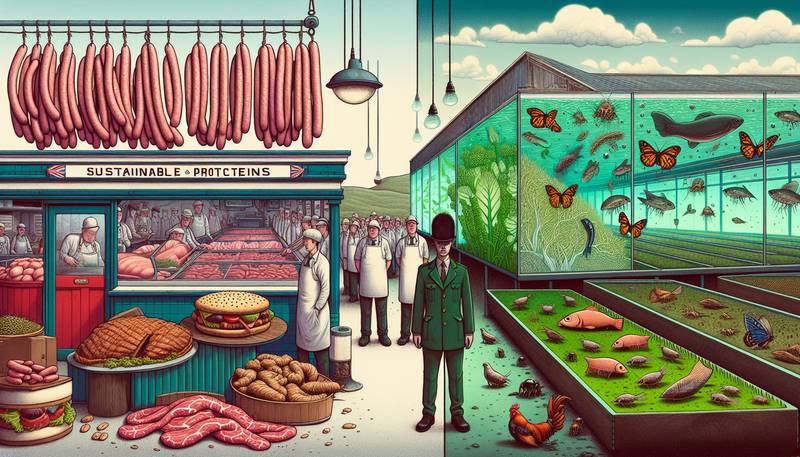Sustainable Proteins Investment in the UK: Analyzing the Future of Protein Sources

Shifting Focus on ProteinProtein sources are undergoing a makeover fit for a royal ball. Gone are the days when the only options were chicken, beef, or the occasional fish that swam right into your dinner plans. Today’s protein seekers are branching out—likely because conventional sources have been hogging the spotlight…and maybe the entire buffet. The shift towards sustainable proteins is not just a trend; it’s a culinary revolution that’s more exciting than finding a five-spot in your winter coat.But what does this mean for the investment landscape in the UK? This is where it gets juicy—without actually being juicy. The demand for alternatives like plant-based proteins and lab-grown meat is growing faster than a toddler on a sugar high. Investors are scrambling to get in on the action, eager to dive into a world where beans and peas get to bask in the limelight.The Great Protein DebateThe protein debate rages on. Traditionalists cling to their steaks and hearty fish fillets, while new-age foodies preach the gospel of peas and lentils. The crux of the matter? Sustainability versus tradition. A recent survey revealed that approximately 75% of UK consumers are open to trying alternative proteins, while the remaining 25% are possibly busy debating the merits of donning a meat apron or giving it up entirely.Let’s not mince words—sustainability is no longer just a buzzword on eco-warrior Facebook pages. Behind the curtains, scientists are toiling away like mad wizards, concocting protein sources that reduce environmental footprints faster than a cheetah at a marathon. The world of protein is evolving, and it’s taking us along for quite the ride.Investment Opportunities GaloreWith this protein revolution comes a goldmine of investment opportunities. If you’ve ever wanted to invest in something that’s both tasty and planet-friendly, now is the time to hop on the bandwagon. The UK is bubbling with the promise of innovative startups focused on sustainable proteins, and they’re attracting venture capital like a moth to a flame. Here are some areas ripe for investment: - Plant-based proteins: Companies are creating delicious alternatives that are so convincing, even cows are starting to look over their shoulders.
- Cultivated meat: Lab-grown meat is like the cool science experiment we all wanted to do in school but didn’t have the funding for. Now, it’s here, and it’s actually delicious!
- Insect proteins: Yes, you read that right. Some brave souls are investing in crickets and mealworms. It’s a whole new world of snacks that might make you reconsider what’s crawling around in your pantry.
Investment in these areas not only opens the door to financial gains but also contributes to a healthier planet. It’s like a two-for-one deal, except without the pushy salesman.Challenges and ConsiderationsEvery rose has its thorn, and the sustainable protein sector is no exception. Even while some may be ready to dive knee-deep into the world of alternative proteins, hurdles loom like unsightly potholes on the road to success. Regulatory challenges, consumer acceptance, and the need for robust production methods are just a few of the obstacles.The truth is: It takes more than just a clever marketing slogan to woo consumers. Taste and texture matter. If the final product resembles a rubber shoe, you might as well start ticketing people for attempted crimes against their taste buds.Let’s not forget the cost factor. While lab-grown meat might tantalize the taste buds, the price tag can leave your wallet gasping for breath. For sustainable proteins to truly take root, they need to become not only desirable but also affordable. Protein-Fueled FutureAs we glance into the crystal ball (which, let’s be honest, is probably just a shiny ornament), it’s clear that sustainable proteins have a promising future. The investment landscape is rich with potential, and those willing to be adventurous may very well reap the rewards of their choices. While the road ahead may be bumpy, the destination—a world where delicious, nutritious, and sustainable protein reigns supreme—seems closer every day. Awareness and innovation are the keys to unlocking a new era of eating, where every bite can make a difference—one protein-packed punch at a time.In the grand scheme of things, investing in sustainable proteins is more than just a financial decision; it’s a chance to be part of something groundbreaking. As the food industry continues to evolve, those who dare to embrace change might just find themselves feasting at the table of success. After all, when it comes to protein, sustainability is no longer optional; it's essential—let’s just hope it comes with a side of fries.
|
|







